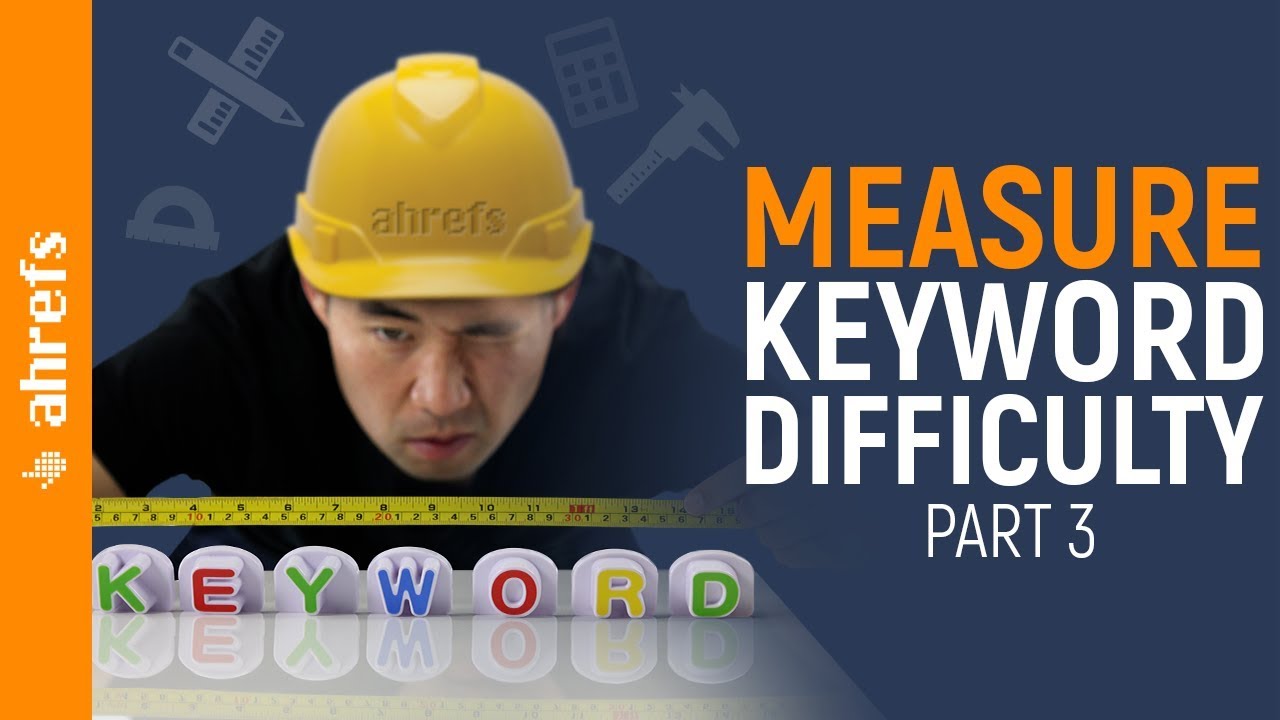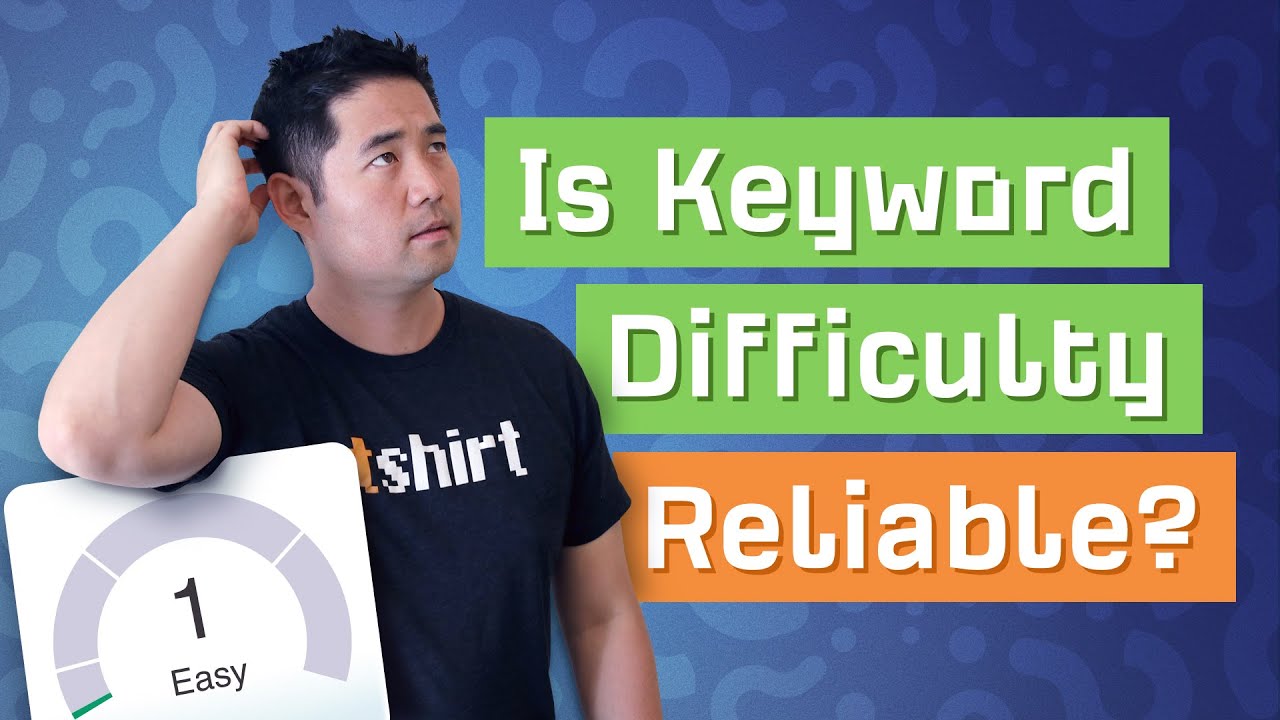Keyword difficulty is a fundamental concept in the field of search engine optimization(SEO) that determines the level of competition for specific keywords in search enginerankings. It provides valuable insights into the effort and resources required to achieve desirable rankings for targeted keywords.
By understanding keyword difficulty in SEO, professionals and website owners can develop effective strategies to improve their organic visibility and drive more relevant traffic to their websites. In this article, we will explore the significance of keyword difficulty, its measurement factors, and how it can be incorporated into an SEO strategy.
What Is Keyword Difficulty In SEO?

Keyword Difficulty: How Hard is it to Rank in Google? [3.4]
Keyword difficulty refers to the level of competition a specific keyword has in search engine rankings. It is a metric used in search engine optimization (SEO) to determine how challenging it will be to achieve a desirable ranking position for a particular keyword.
Keywords with high difficulty are highly competitive, meaning many websites are targeting and optimizing their contentfor those keywords. On the other hand, keywords with low difficulty have less competition, making it relatively easier to rank well for them.
Several factors contribute to keyword difficulty, including the number of websites competing for the keyword, the authority and credibility of those websites, the strength of their backlink profiles, the relevance of content to the keyword, and the on-page optimization of web pages targeting the keyword.
Understanding keyword difficulty is crucial for developing an effective SEOstrategy. It helps SEO professionals and website owners prioritize their efforts, identify less competitive keywords or long-tail variations, analyze competitors, and allocate resources effectively. By considering keyword difficulty, one can make informed decisions and focus on keywords that offer the best opportunities for achieving higher search engine rankings and driving organic traffic to their website.
How Is Keyword Difficulty Measured?

How to Measure Keyword Difficulty and Rank on Google
Keyword difficulty is measured using various factors and metrics to gauge the level of competition for a specific keyword. While different SEO tools and platforms may use slightly different methodologies, the following are common elements considered when measuring keyword difficulty:
- Competition Analysis -This involves assessing the number of websites that are already targeting the keyword. The more websites competing for a keyword, the higher the difficulty. Tools analyze the top-ranking pages and domains to determine the level of competition.
- Domain Authority(DA) -Domain authority is a metric that reflects the overall credibility and strength of a website. Websites with higher domain authority tend to have an advantage in ranking for competitive keywords. Keyword difficulty assessment often considers the authority of competing domains.
- Backlink Analysis-Backlinksare an essential factor in SEO and their quality and quantity impact keyword difficulty. Tools analyze the backlink profiles of competing pages to evaluate the strength of their link profiles. Websites with a stronger and more authoritative backlink profile may have higher keyword difficulty.
- Content Relevance -Search engines aim to provide users with the most relevant results. Therefore, content relevance to a keyword is an important aspect of keyword difficulty. Tools may assess the on-page optimization, content quality, and keyword usage on top-ranking pages to determine the relevance of content to a particular keyword.
- On-Page Optimization -On-page optimization refers to the optimization of elements within a webpage, including titles, headings, meta tags, and content. Proper on-page optimization can positively impact keyword difficulty. Tools may evaluate the presence and optimization of keywords in various on-page elements to determine the level of optimization for a keyword.
Based on these factors, SEO tools assign a keyword difficulty score or rating. This score typically ranges from 1 to 100, with higher scores indicating higher levels of difficulty. It's important to note that keyword difficulty scores are relative and can vary across different tools, so it's advisable to compare and analyze multiple sources to get a comprehensive understanding of keyword difficulty for effective SEO planning.
Tools For Assessing Keyword Difficulty
Several SEO tools provide valuable insights into keyword difficulty, helping website owners and SEO professionals make informed decisions about their keyword targeting strategies. Here are some popular tools for assessing keyword difficulty:
- Ahrefs -Ahrefs offers a comprehensive keyword research tool that includes a Keyword Difficulty metric. It provides a score ranging from 0 to 100, indicating the difficulty of ranking for a particular keyword based on the backlink profiles of the top-ranking pages. Ahrefs also provides additional data such as search volume, click-through rates, and SERPfeatures.
- Moz Keyword Explorer -Moz Keyword Explorer is another widely used tool that provides a Keyword Difficulty score. This score takes into account multiple factors, including domain authority, page authority, and the number of linking root domains. Moz also offers other valuable SEO metrics and features, such as organic CTR analysis and SERP analysis.
- SEMrush -SEMrush is a versatile SEO tool that offers a Keyword Difficulty metric as part of its extensive keyword research toolkit. The Keyword Difficulty score, ranging from 0 to 100, estimates the competitiveness of a keyword based on the strength of the domain ranking in the top search results. SEMrush also provides additional features like competitor analysis, backlink analysis, and on-page SEO recommendations.
- Google Keyword Planner -Google Keyword Planner, a free tool within Google Ads, provides keyword ideas and search volume data. While it doesn't explicitly offer a keyword difficulty score, you can gauge the competition level by examining the suggested bid range for keywords. Higher suggested bids often indicate more competitive keywords.
- KWFinder -KWFinder is a user-friendly keyword research tool that includes a Keyword Difficulty metric. It assigns a score from 0 to 100 to indicate the difficulty of ranking for a keyword. KWFinder also provides related keyword suggestions, search volume data, and SERP analysis to help with your keyword research.
These tools vary in terms of features, pricing, and user interface. It's advisable to explore and compare different tools to find the one that aligns with your specific SEO needs and budget. Additionally, it's recommended to use multiple tools for a more comprehensive understanding of keyword difficulty and to cross-reference the data provided.
Incorporating Keyword Difficulty In SEO Strategy
Incorporating keyword difficulty analysis into your SEO strategy is crucial for maximizing your efforts and achieving optimal results. Here are some effective ways to integrate keyword difficulty into your SEO strategy:
- Diversify your keyword targeting -Instead of solely focusing on highly competitive keywords, consider targeting a mix of difficulty levels. This approach allows you to capture both low-hanging fruit (low-difficulty keywords) and long-term goals (high-difficulty keywords). Balancing your keyword portfolio helps you generate traffic and rankings in the short term while gradually building authority for more competitive keywords.
- Leverage long-tail keywords -Long-tail keywords are longer, more specific search queriesthat generally have lower search volumes and lower keyword difficulty. Targeting long-tail keywords can be an effective strategy, especially for newer websites or niche markets. These keywords often have higher conversion rates and can help establish your website's authority in a specific area.
- Analyze competitor strategies -Conduct competitor analysis to understand how they are targeting keywords and what strategies they are implementing. Assess their domain authority, backlink profiles, on-page optimization, and content relevance. This analysis can help identify keyword opportunities, uncover gaps in their strategies, and inform your own approach to outranking them.
- Optimize content and on-page elements - Optimize your content and on-page elements to increase your chances of ranking for targeted keywords. Conduct thorough keyword research and ensure that your content aligns with search intent. Optimize page titles, headings, meta tags, and image alt tags with relevant keywords. Focus on delivering high-quality, valuable content that resonates with users and search engines.
- Prioritize resources and efforts -Keyword difficulty analysis helps you allocate your resources effectively. Concentrate your efforts on keywords that strike a balance between search volume and competition level. Assess the potential return on investment (ROI) for each keyword and prioritize those that offer the best opportunity for driving relevant traffic and achieving your goals.
By incorporating keyword difficulty analysis into your SEO strategy, you can make informed decisions about which keywords to target, prioritize your efforts, optimize your content effectively, and stay ahead of the competition. Continuously monitor and adjust your strategy based on changes in keyword difficulty and search trends to maintain a competitive edge in the ever-evolving SEO landscape.
How Does Keyword Difficulty Impact SEO Strategy?

How Reliable are Keyword Difficulty scores?
Keyword difficulty has a significant impact on SEO strategy as it directly influences the effectiveness and outcomes of your optimization efforts. Here are some ways in which keyword difficulty impacts SEO strategy:
- Keyword Targeting -Keyword difficulty helps determine which keywords to target. High-difficulty keywords may require substantial resources and time to rank well, while low-difficulty keywords can offer quicker wins. By understanding keyword difficulty, you can prioritize your keyword-targeting strategy and allocate your resources accordingly.
- Competitive Analysis -Keyword difficulty analysis involves assessing the competition for specific keywords. Understanding the level of competition allows you to evaluate the strength and strategies of your competitors. This analysis helps you identify opportunities, gaps, and areas where you can differentiate yourself to gain an advantage.
- Content Optimization-Keyword difficulty plays a crucial role in optimizing your website content. By analyzing keyword difficulty, you can identify the level of optimization required to compete for a particular keyword. This analysis informs your content creationand optimization efforts, ensuring that your content is highly relevant, valuable, and optimized for the targeted keywords.
- Resource Allocation -Keyword difficulty helps you allocate your resources effectively. Highly competitive keywords often require more significant investments in content creation, link building, and promotion to rank well. By understanding keyword difficulty, you can determine how much time, effort, and budget to allocate to different keywords and ensure that your resources are utilized efficiently.
- Strategic Planning -Keyword difficulty analysis allows you to develop a strategic SEO plan. It helps you set realistic goals and expectations based on the competitiveness of keywords. You can create a roadmap that outlines the steps needed to improve rankings for difficult keywords, while also targeting less competitive keywords to generate traffic and visibility in the shorter term.
- ROI Evaluation -Keyword difficulty analysis helps assess the potential return on investment (ROI) for your SEO efforts. Highly competitive keywords may have high search volumes but also require significant resources. By evaluating the keyword difficulty, you can prioritize keywords that offer a balance between search volume and competition, ensuring that your efforts yield the best possible results.
Can I Rank For Highly Competitive Keywords With High Difficulty?
Ranking for highly competitive keywords with high difficulty is challenging but not impossible. While it requires a strategic and comprehensive approach, it is still feasible to achieve favorable rankings for such keywords. Here are some factors to consider when targeting highly competitive keywords:
- Strong Domain Authority -Building a strong domain authority is crucial for competing in highly competitive spaces. Focus on improving your website's overall authority by obtaining high-quality backlinks, creating valuable and shareable content, and optimizing your website for a great user experience.
- Exceptional Content and User Experience -Create content that surpasses the existing competition in terms of quality, depth, and relevance. Develop comprehensive and well-researched articles, infographics, videos, or interactive elements that provide unique value to your target audience. Additionally, prioritize user experience, ensuring fast page load times, mobile optimization, and intuitive navigation.
- Link Building -Acquiring high-quality backlinks from authoritative and relevant websites is crucial. Develop a solid link-building strategy, such as guest posting, content promotion, influencer outreach, and building relationships with industry leaders. Quality backlinks from reputable sources can significantly boost your website's authority and help improve rankings for competitive keywords.
- Long-Tail and Semantic Keywords -While targeting highly competitive keywords, consider incorporating long-tail and semantic keywords within your content strategy. Long-tail keywords are more specific and less competitive, allowing you to capture niche segments of your target audience. Leveraging these keywords can drive targeted traffic and improve your chances of ranking for broader, more competitive terms over time.
- Content Gap Analysis-Analyze your competitors' content strategies and identify content gaps or areas where you can provide unique value. Develop content that covers these gaps comprehensively, addressing topics or angles that are not adequately covered by the competition. This approach can help attract organic traffic and establish your website as a valuable resource.
- Patience and Persistence -Ranking for highly competitive keywords often takes time and persistence. Be patient and consistent with your SEO efforts, continuously monitoring and refining your strategy. Keep an eye on changes in search trends, adjust your approach as needed, and stay committed to providing value to your audience.
People Also Ask
How Do I Choose Keywords With The Right Difficulty Level For My Website?
Choosing keywords with the right difficulty level requires a balance between competitiveness and relevance to your website. Consider your website's domain authority, resources, and goals. Start by targeting a mix of high, medium, and low difficulty keywords to diversify your strategy and gradually aim for more competitive keywords as your website's authority grows.
Can Keyword Difficulty Change Over Time?
Keyword difficulty can change over time. Factors such as search trends, new competitors entering the market, algorithm updates, and changes in user behavior can impact keyword difficulty. It's important to regularly monitor and reassess keyword difficulty to adjust your SEO strategy accordingly.
Are Long-tail Keywords Always Low Difficulty?
While long-tail keywords generally have lower search volumes and competition, it's not always the case that they are low difficulty. Long-tail keywords can still have varying levels of competition depending on the specific niche and industry. It's important to conduct keyword research and analyze the competition for each long-tail keyword you consider targeting.
Conclusion
In the ever-evolving world of SEO, keyword difficulty remains a crucial factor in determining the success of a website's organic search rankings. By accurately assessing keyword difficulty, SEO professionals and website owners can make informed decisions about which keywords to target and how toallocate their resources effectively.
Armed with this knowledge, one can develop a well-rounded SEO strategy that targets a mix of difficulty levels, leverages long-tail keywords, and incorporates competitor analysis and content optimization. Ultimately, keyword difficulty serves as a guiding compass, enabling website owners to navigate the competitive landscape and achieve improved visibility and organic traffic for their websites.
